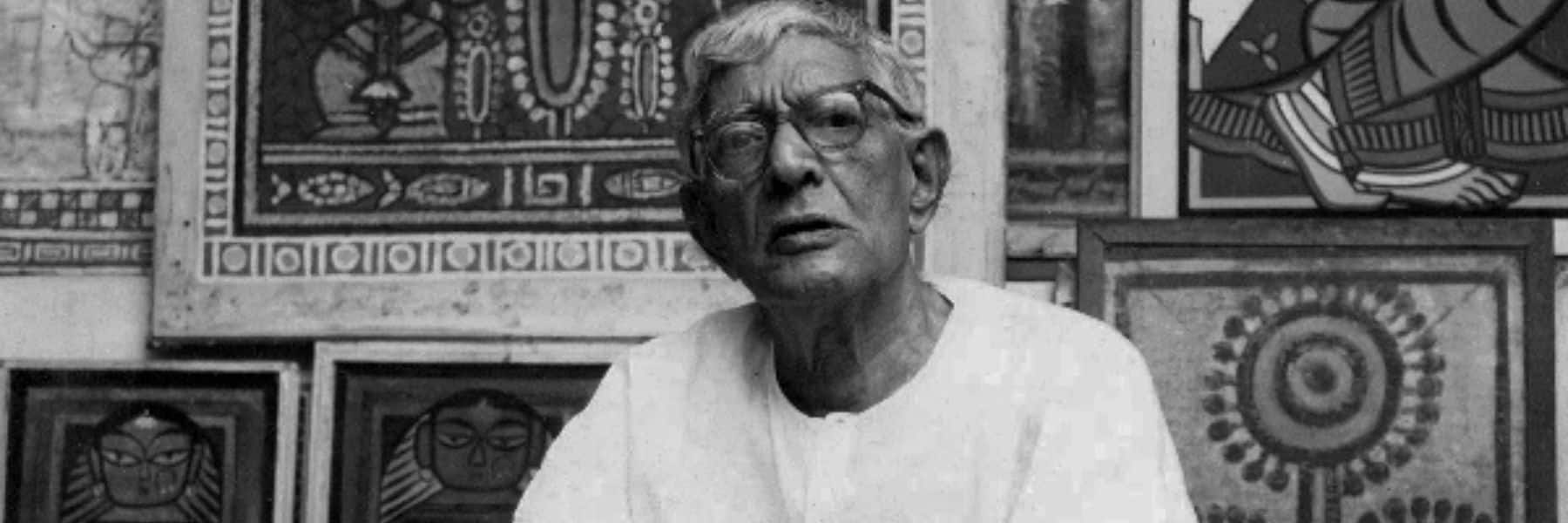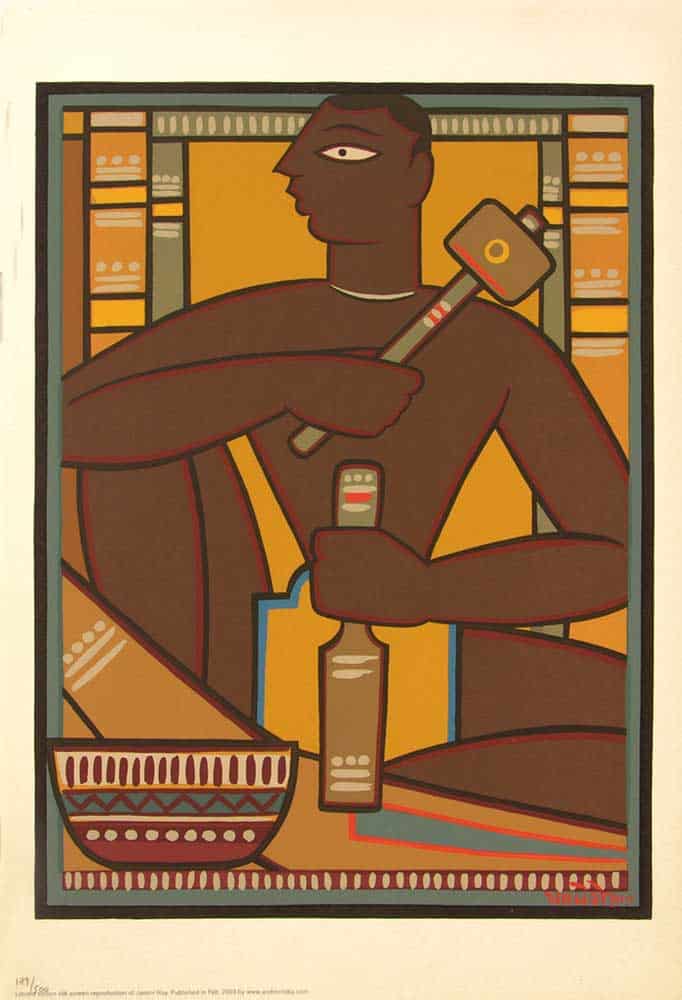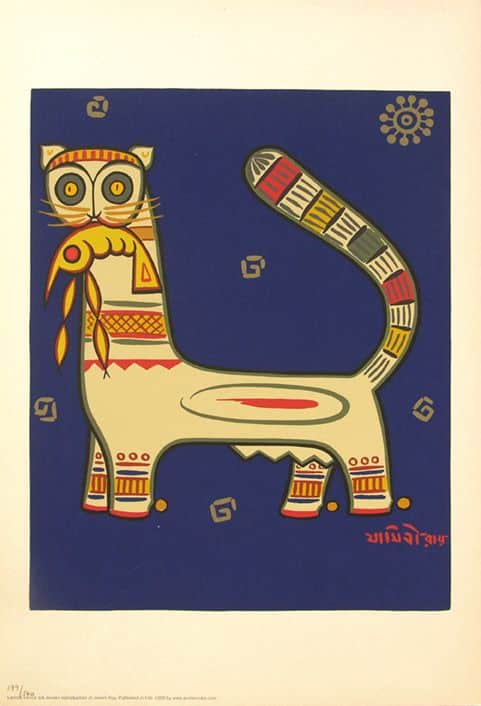
JAMINI ROY: AN ARTIST FOR ALL SEASONS
Today, artist Jamini Roy (1887-1972) is recognized as one of the most important figures in Indian art and credited for popularizing a new style that celebrated the uniqueness of India’s artistic heritage. He rejected Western aesthetic conventions of the time and instead drew traditional Indian art forms, from Bengali folk paintings to Bishnupur terracotta reliefs, and his themes focused on scenes from rural village life and Indian mythology. We reached out to leading art historian Sandhya Bordewekar for her insights on the influence of Jamini Roy and his continued legacy in Indian art.

JAMINI ROY: AN ARTIST FOR ALL SEASONS
by Sandhya Bordewekar
This year, April 11 marked the 135th birth anniversary of Jamini Roy. 50 years after his death in 1972, this wonderfully versatile Bengali artist’s vast repertoire of paintings, drawings and prints still sustains a strong emotional and vibrant visual connection to every Indian. Each Jamini Roy painting, print or drawing is a prized possession on the wall of every lucky family that owns one.

What makes Jamini Roy — a scrawny lad from Beliatore village, Bankura district, West Bengal, who traveled to Santiniketan, learned the techniques of formal studio painting from the masters there, then chucked it all off to develop an earthy style all his own — relevant even today? That’s because viewers can easily relate to the simple elegance of Tribal Women (pictured above) and the tongue-in-cheek humor of Cat holding Lobster, both vibrantly colored prints, where each artwork resonates strongly with viewers, drawing them into the work with a smile on their faces! Who would not like to see these women or the cat watching you happily from a wall in your home?
It is therefore no wonder that the administration at Bishnupur, a popular tourist destination in Bankura, recently decided to pay official and public homage to this well-loved artist from their region, by painting the walls of government offices and private homes in the style of Jamini Roy. In fact, in 2017, Google also commemorated his 130th birth anniversary year with a doodle in the iconic Jamini Roy signature style! Not many Indian artists can claim such an achievement.

Roy’s extensive oeuvre traces his artistic journey as he re-invented form and color in folk and tribal art as a modern idiom, and presented it in a contemporary style, yet with the lively earthiness of everyday life. He discovered his true ‘voice’ in these vibrant traditions that he found around him in Bankura. In the print Sanathal Carver (pictured above), one can see the coming together of his in-depth understanding of the human form, the dark muscular body, with one hand lifted up to strike, the other steady, holding the blade that would carve the large piece of wood at his feet.
Roy experimented with indigenous art materials, exploring natural mineral and vegetable-based colors and pigments from seeds, flowers, tree bark, powdered rock and mud. His color palette was restricted to only seven natural colors – Indian Red, Yellow Ochre, Vermillion, Grey, Blue, Cadmium Green and White. From the regular canvas and paper, he often shifted to cloth, woven mats and wood coated with lime. His simple content spanned popular religious themes from the Indian epics, ordinary villagers at work, animals, mother and child, and women — youthful and elderly. These were understood and enjoyed by everyone. Roy wanted his works to hang in every Bengali home and this was one way in which he did it. The other way was to keep prices very affordable.
Jamini Roy created numerous Bal Krishnas — the crawling baby and the mischievous boy — among benevolent cows and the Gopis who milked them and churned the milk into butter that Krishna loved! For example, Makhan Chor is a lovely print that captures the innocent pranks of childhood — a child bending over to help Bal Krishna climb over his back to reach the pot of butter hanging from the ceiling, while another child keeps watch, and a shocked Gopi coming suddenly upon them. There is also a rare canvas of Krishna as a toddler, Bal Krishna with Cows and Gopis, where the artist cleverly places the five seated cows, benignly watching over the baby as two Gopis look on.
The Bal Krishna image inspired another popular theme – mother and child — that Jamini Roy also explored widely. The print of Mother & Child in stunning cobalt blue and cadmium green is a fine example of Roy’s sensitive exploration of this theme. Another print, Bal Krishna and Yashoda, is a variation on this theme but placed in a homely narrative framework. A much more stylized work is Krishna playing Holi, a print that captures the boy Krishna and his friend joyously splashing color on the Gopis!
Jamini Roy’s other love was animals — especially cats and the long-necked terracotta horses traditionally sculpted by the potters of Bankura and known as Bankura horses. He made these works lovingly and with a tongue-in-cheek sense of humor.

Art historian Partha Mitter has described Jamini Roy as “the father of the folk renaissance in India who created an alternative vision of modern Indian identity.” Mitter has gone ahead to analyze Roy’s return to roots as his “weapon of resistance to colonial rule.” Such was the impact of his work that it got international recognition, with some of his paintings being compared to those of Henri Matisse.
Over his lifetime, Jamini Roy is believed to have created more than 20,000 artworks (most of them were left unsigned!), the most ambitious being his 1946 work, Ramayana, spread over 17 canvases, tracing the entire epic. His popularity was at its height in the 1940s, when his work was widely collected across Europe and Bengal. In 1955, the Government of India acknowledged the contribution of this great artist and conferred him with the Padma Bhushan, one of India’s highest civil awards, a fitting honor for a true icon of Indian art.

Leave a Reply
You must be logged in to post a comment.